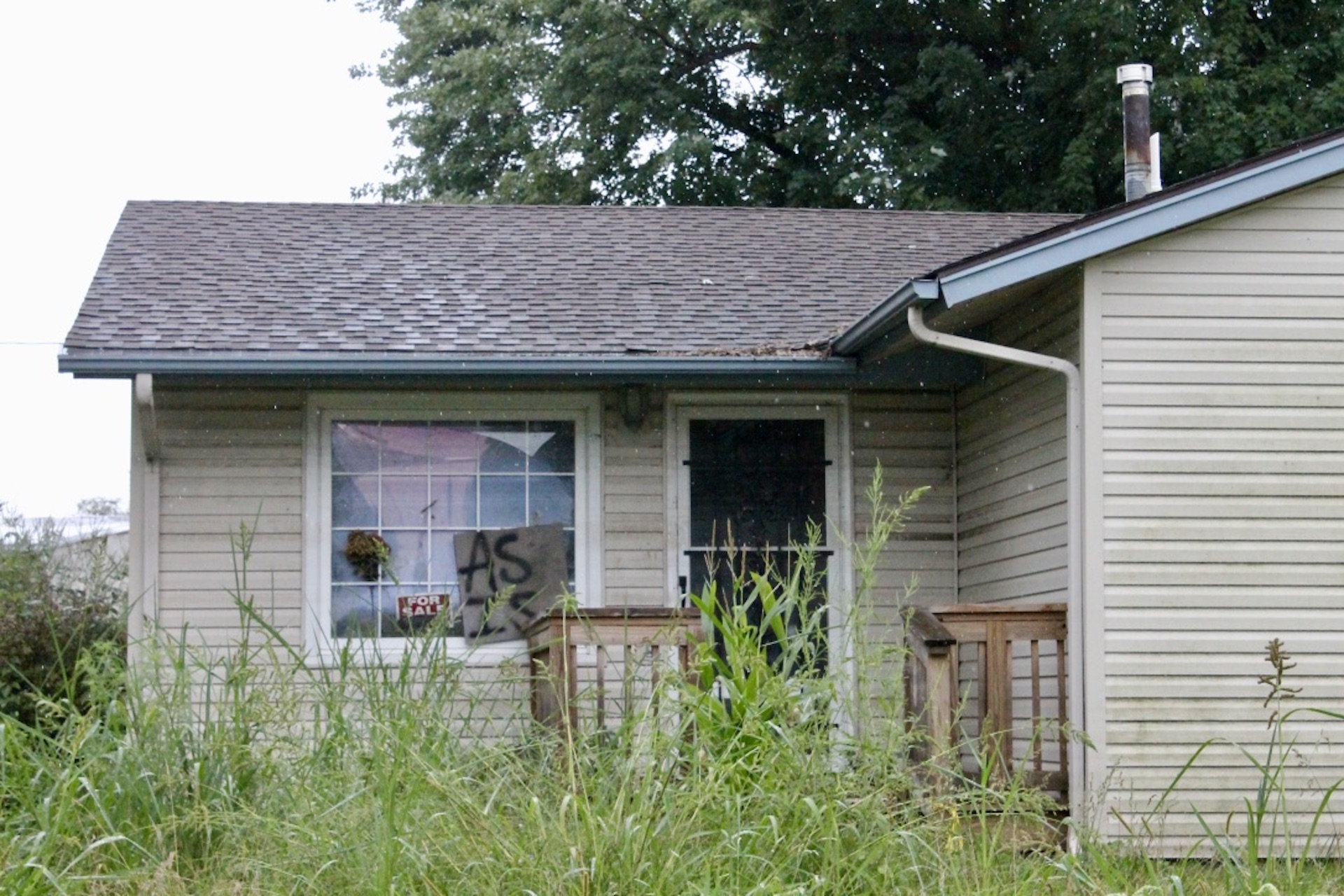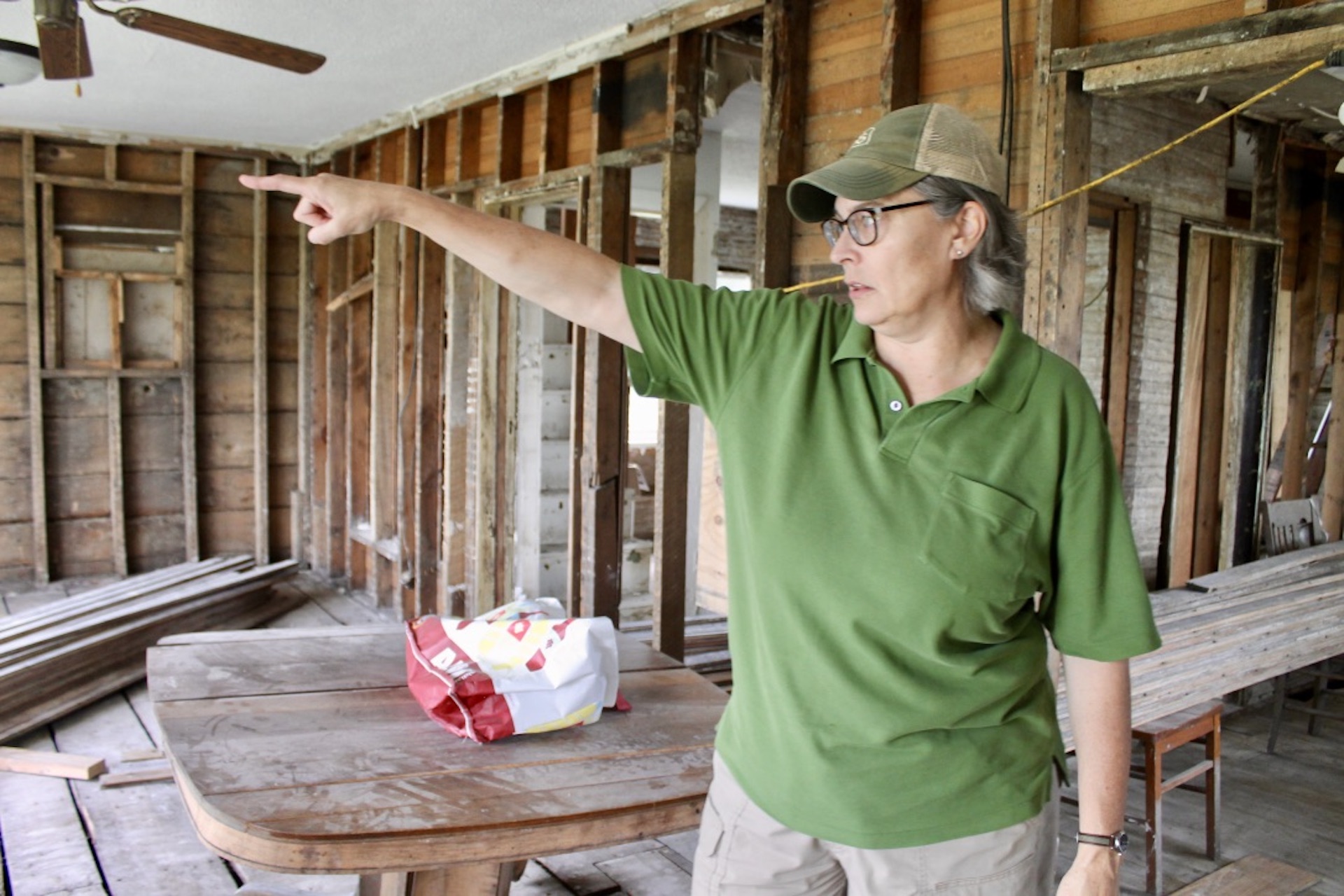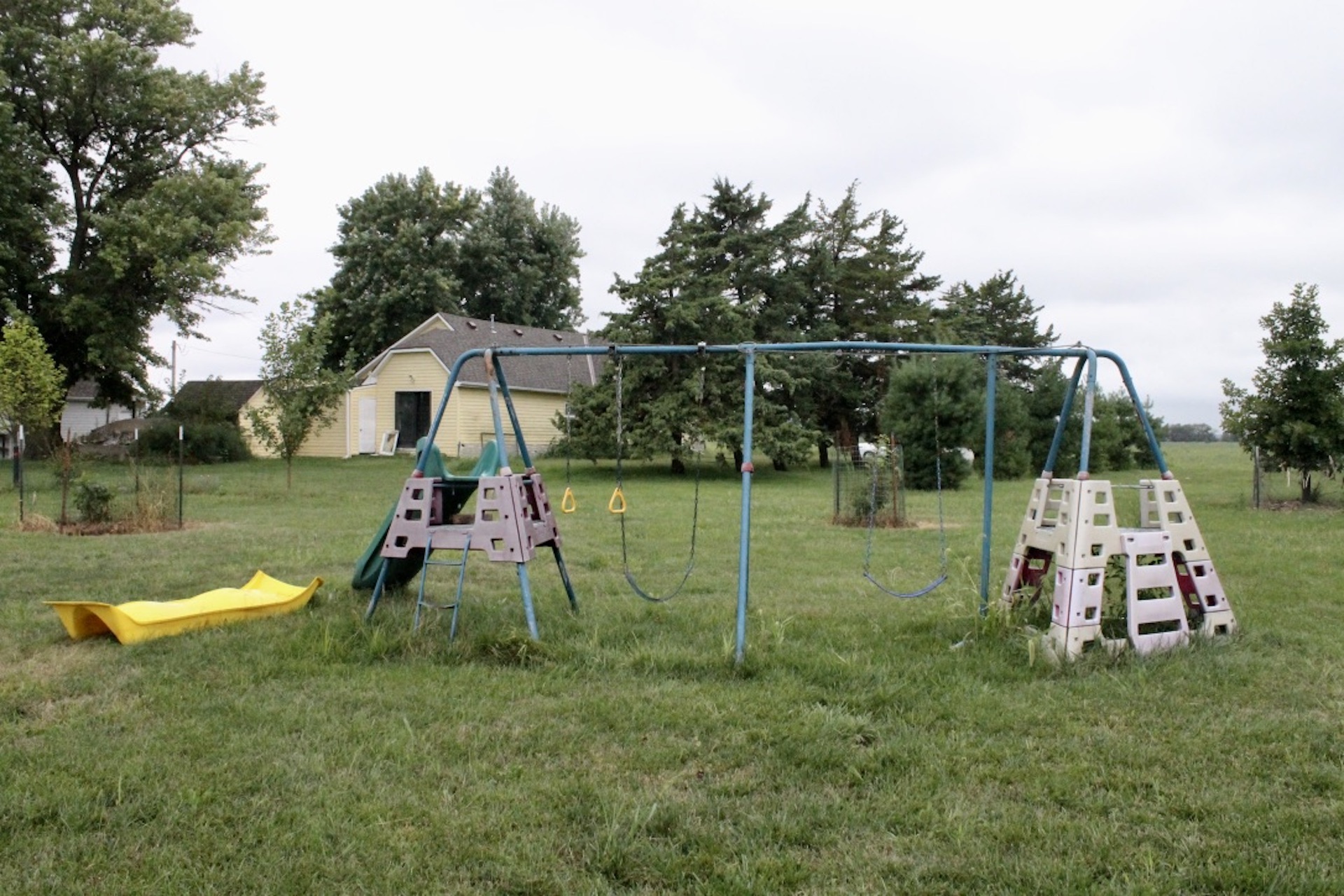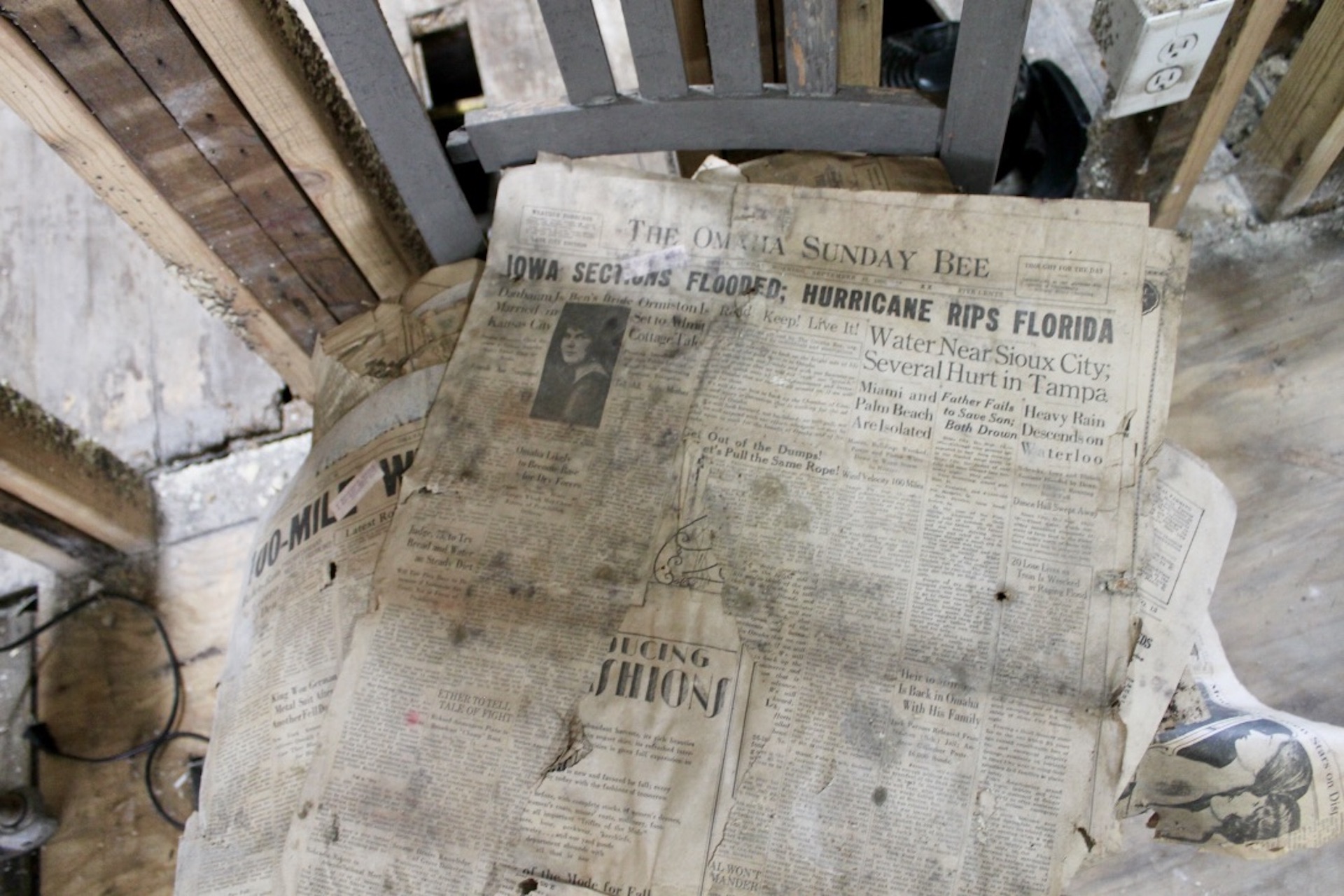PACIFIC JUNCTION, Iowa — When the floodwaters receded in Pacific Junction in March, you could see two striking things: cornstalks washed up on the roofs of houses and rotting catfish strewn across the fields.
The view is hardly better today.
Beige port-a-potties dot the intersections of residential streets, where unmowed lawns grow unruly. In the windows of weathered houses where shiplap slides off the walls, cardboard “FOR SALE: AS IS” signs beg someone to buy.
One house wears green and yellow graffiti insulting both the Federal Emergency Management Agency and the Army Corps of Engineers: “ARMY CORPS THANK FOR HELP - 0. THANKS FOR HELP FEMA - 0. 0 + 0 = 00.”
Aside from the occasional appearance of a resident gathering garbage into piles outside her home, the town is dead quiet. The Missouri River, the source of all that trouble, is still flush with the top of the river bank.
It’s been five months since a historic flood leveled the roughly 400-person town, along with countless others situated along the Missouri River, in states like Nebraska, Missouri, Kansas, and Iowa. Nearly ten-foot water surges swept miles inland, washing through every home in Pacific Junction.
Aerial images of the region showed staggering loss: century-old farms destroyed, thousands of livestock drowned, miles of highways submerged and levees destroyed. Forced to evacuate nearly overnight, residents of Pacific Junction couldn’t access their homes for weeks after the flood, which hit with over a month left in the school year.
All told, the disaster will cost at least $1.6 billion in Iowa alone.
But now that the hemorrhaging has stopped, the real work begins. Staring down tens or possibly hundreds of thousands of dollars in repairs, the local residents –– some of whom have known no other home –– now have to decide whether to rebuild again.
Most think it’s not worth it.

Hundreds in the town have demanded that city officials sign off on using emergency assistance funds from FEMA to provide them with buyouts, which would allow the city to purchase residents’ homes at their assessed value.
It gives residents a way to recoup the value of their house and have some money to buy or rent elsewhere: While FEMA offers some flood victims small grants of up to $34,900 to help repair damage to their homes, that amount isn’t nearly enough to rebuild from the ground up. And though the Small Business Association allowed residents to apply for low-interest loans up to $200,000, that forces people to take on a mountain of debt.
But the effort to secure buyouts has caused a rift between those who want to leave and those who’ve decided to stay — some of whom view the departed as traitors for abandoning the town.
“If FEMA comes in and says, ‘Here's your $30,000,’ and they leave and they go somewhere else, and they don't rebuild, [their homes] turn to green space. Forever. Deeded back to the county to mow. Well, that’s pretty much going to wipe out the entire city,” Devin Embray, president of the Mills County Economic Development Foundation and the superintendent of the area school district, told VICE News in his Glenwood, Iowa, office.
That’s because federal statutes mandate that any city conducting buyouts for disaster relief with FEMA money have to demolish the properties they acquire, with the land they sit on used as open public space in perpetuity.
As climate change increases the likelihood that natural disasters will strike, a number of cities have taken advantage of FEMA’s buyback programs — one of which allows jurisdictions in flood-prone areas to prevent widespread damage by buying properties before a disaster hits.
Nashville has been doing it for decades: Officials there have proactively purchased some 400 homes and lots in recent years, spending more than $43 million. Even Nebraska, which faces close to $1.5 billion in recovery costs from flooding this spring, avoided damage to some smaller towns close to the river where officials bought homes that had flooded repeatedly.
FEMA’s post-disaster buyback program, though, is its longest-running and most successful. The agency funded more than 40,000 individual buyouts between 1989 and 2017, many of those in Iowa.
A spokesperson for FEMA told VICE News that the agency has disbursed nearly $27 million since 2010 to help 30 cities in Iowa buy disaster-prone properties, including in Des Moines, Dubuque, Cedar Rapids, and Iowa City.
“Buyouts are a smart option if your goal is to eliminate flood damages,” says Rob Moore, a senior policy analyst at the Natural Resources Defense Council. “There’s one way to guarantee flood damage will never happen on a property again, and that’s to make sure there’s nothing on the property that can be damaged.”
Communities in Southwest Iowa, where Pacific Junction sits, have long been sensitive to the precarity of their location. In nearby Hamburg, a town roughly triple the size of Pacific Junction, residents have lobbied lawmakers for years to make their levees stronger and higher, to no avail.
But Pacific Junction has never been forced to confront the prospect of offering buyouts — for decades, levees and raised railroad tracks on nearly every side of the town prevented major flooding before.
And local officials aren’t eager to offer them. Buyouts would, essentially, erase the city lot by lot.
“The city does not want buyouts, because then the city’s gone,” says 45-year-old Jamie Cheyney, a healthcare worker whose home just outside the Pacific Junction city limits was destroyed by the flood. “But these people have nowhere to go. Our property is never going to be worth anything again. I doubt anybody will buy a house in PJ again.”
Flood-relief meetings have devolved into shouting matches, Cheney says, with people demanding concrete answers about if or when they’ll receive a buyout, and accusing city officials of withholding information.
Moore tells VICE News that FEMA-financed buyout projects are notorious for taking years to complete –– with new NRDC research showing that some can take up to five years. “Nobody wins the way we do it now,” he says.
Fran Parr, a civil engineer and longtime Pacific Junction resident, is more blunt: “It really is a shit show, you know?”

‘This is survival’
Founded in 1871 by the Burlington & Missouri River Railroad as a freight transit hub for Mills County, Pacific Junction enjoyed decades of relative prosperity before its growth peaked at the beginning of the 20th century.
But its population has nearly halved since then, and the town’s wealth has dwindled.
Today, it’s one of the poorer towns in the area. Berkshire Hathaway estimates that the median home value is $70,000, about $50,000 lower than the county average. The vast majority of people there own their homes. There’s no full-service restaurant, no supermarket, no movie theater.
“It wasn’t, like, a prosperous community to begin with,” Cheyney says. “These are people who don’t have the money to go somewhere else.”
It has also, historically, been safe from flooding — the town had never before seen a flood like the one that destroyed it this spring.
Pacific Junction Mayor Andy Young, who has lived in the town for over five decades, told a local outlet in April that “never in my lifetime” did he expect a disaster of this magnitude. The closest the town had come to flooding was in 1993, when it experienced some “seep,” or water from the river basin that pushes up through the ground and creates marsh-like conditions.
But over the last year, the region saw a confluence of extreme weather conditions that increased the likelihood of flooding. Flooding in the fall of 2018 saturated soil in the ground, while heavy snows last winter blanketed, then froze, the water. When higher-than-average rainfall hit the area in the spring along with warm air that loosened it all, the snowmelt caused the river basin to overflow.
And a levee failure southwest of Pacific Junction forced the Missouri River to backfill, pushing water north and flooding the town.
Cheyney’s hundred-year-old home once belonged to her grandmother, and she’s lived there off and on since high school. It’s where the family celebrated Christmas every year, and when her grandma got too old to cook for the holiday, Cheyney took over.
She invited friends over for vacation, had bonfires in the summer, camped in the timber, and went mushroom hunting; she sank all of her money into refurbishing the house. She installed a new roof, windows, and flooring; she painted the exterior. She’d planned on redoing the kitchen.
“I thought I was going to live there forever,” Cheyney says. “Thank god I didn’t have that finished. Everything just went down the drain.”
Cheyey didn’t have access to the house for three weeks after the flood, and when she got back, she found that she’d lost everything. All of her belongings were covered in sewage, thanks to a treatment plant in Omaha whose contents leached into the floodwater.
So Cheney took her pets and moved into the guest room of her father’s home in the neighboring town of Glenwood.
The rest of Pacific Junction was also left to scatter. Dozens decamped to other towns, driving down vacancy rates in those rental markets, or to other states. Some moved in with friends and family; other families are sharing hotel rooms in adjacent towns. Some are living in campers by the river.
“I don’t know what’s going to happen if these people can’t find housing before the winter,” Cheyney says of her neighbors. “You can’t live in a camper, in the Midwest, in the winter.”
Other people skipped town in a truer sense, buying property in another area (“before their credit goes south,” Parr says) and refusing to pay the mortgage on their homes in Pacific Junction — or flood insurance that’s likely to spike into the thousands.
Though the Pacific Junction residents who have remained in the area have been vocal about wanting buyouts, they can’t do it alone. Local officials have to request FEMA mitigation funds from the state in order to purchase flooded properties. State officials then review those requests, as does FEMA.
Parr says she led the push to urge city and county officials to begin the buyout process, writing to the county’s board of supervisors with signatures from residents. About 40 people signed on initially, though Parr estimates that, over time, roughly 80 percent of the town expressed interest in taking a buyout if offered one.
But it’s been mostly radio silence from lawmakers, residents say.
“They haven't been transparent. I find that a huge source of frustration, a huge source of frustration. Nobody knows what the status is,” Parr says. “Some people who are involved at the periphery come in and say, ‘Well, you know, it’s government, it's going to take a while.’ I don't give a shit. I went back and actually pulled out some of the steps from prior disasters, [and] we're not rewriting this fucking playbook. It's out there, you know?”

Neither the president nor the vice president of the Mills County Board of Supervisors returned VICE News’ request for comment.
“This is survival for people,” Cheyney says. “People are paying mortgages on houses down there that need to be torn down. And then they’re trying to live as well.” She calls the buyout discussions “a nightmare.”
Because the entire town was under mandatory evacuation orders for 25 days, there’s been no physical, central meeting place for residents, adding to their sense of isolation. Emergency response officials have had to rely on Facebook to communicate with flood victims.
While county officials held sporadic meetings this summer to update residents about recovery efforts, Cheyney says they mostly turned into screaming matches. “It was too depressing, so I stopped going,” she says. “Some people were just angry, and they wanted someone to yell at. Then there was the big city-versus-county [fight]. PJ residents felt like they weren’t getting information from the city council that county residents were getting.”
And then there’s the matter of the levees: The Army Corps of Engineers now has to fix 280 miles of them that were breached or compromised this spring between Council Bluffs, Iowa, and the Missouri state line, a stretch that runs around Pacific Junction. That’ll take many years and billions of dollars, so people who live along the river now have to do so with the knowledge that another season of heavy rain could result in more flooding.
Cheyney, for her part, is weighing a move to Colorado, where her job is based. Rebuilding her house would require borrowing tens of thousands of dollars, at a minimum, to ship in enough dirt to keep the house above the water-table line. She’d need to replace the electrical wiring and all of the walls.
“It’s just cost-prohibitive,” she says. “It’s basically like building from the ground up.”
She recently paid $9,000 to demolish her grandmother’s home.
‘They just walked away from it’
If you tell Andy Young you want a buyout, don’t expect a warm response.
Drill in hand, the lithe Pacific Junction mayor is skulking through the shell of his daughter’s living room. Across the room, a construction crew is heating up Mexican food in a small microwave.
“I don’t do the dog-and-pony show,” Young said when VICE News knocked on the door.
But for the last several months, he’s had to, with presidential candidate after presidential candidate passing through town –– usually on Parr’s arm, who’s a Democrat –– to take a look at how climate change will damage America’s small towns. He’s played host to the governor, and senators, and the county’s emergency management team.
He’s a good spokesman for the town, because he’s in the minority of residents with no plans of leaving. He’s helping construction work along in his daughter’s home, and she’ll likely be the first resident to move back into town.

The mayor is opposed to buyouts in part because of the cost –– while FEMA funds 75 percent of the cost, the town has to pony up 15 percent of the remaining 25. "We're pretty much devastated anyway,” Young told an Omaha ABC affiliate in May. “To come up with 15 percent of however many buyouts –– it'd be astronomical for us.”
But it’s also part pride. Young grew up in Pacific Junction, raised his kids there, built a life.
He takes a swipe at Parr for having a second home, implying that she’s not emotionally invested in Pacific Junction because she has another place to live. (“She comes up here on the weekend and plays farmer,” he cracks.) And he rattles off a list of the people who have begun work on their homes again, and where in town they live.
Young also tells Parr offhand during a brief conversation at his daughter’s home that the city will start sending letters to people who refuse to mow their lawns, and levy fines against them –– a jab at people looking for buyouts who’ve bought homes elsewhere and skipped town.
“People who have said, ‘I'm not going to rebuild’ have let their yards go. And there's people in town who are like, ‘You can't do that’,” she laughs. “Over yards. There was a thread [on Facebook] that a week ago blew up because people weren't mowing their yards.”
But yards, too, are a matter of pride. “They just walked away from it,” Young says. “And they don’t care what it left. But it’s still their property. They’re still responsible for it.”
‘Wiping PJ off the face of the Earth’
The land around the Parrs’ home produced vegetation as far as the eye could see: apples, tomatoes, corn, sunflowers, wildflowers.
She says she’d work at a big table in the front of her home, the dogs lounging on chairs by her side. Her twin sons, now about to start pre-K, would run under the towering trees outside. “Those are bygone days,” she says.
“Our day-to-day is kind of a –– I wouldn't call it entirely a sad existence. We have it better than most others. But it's kind of –– to me, it's not really living,” she says, icy blue eyes glittering. “It's just, you know, you feel like you’ve got this albatross around your neck.”
Coping with the staggering loss, she says, has been overwhelming.
“What I'm genuinely worried about right now is people's mental health,” Parr says. “I had a crack here about about a month ago. I'm like, I can't deal with it. So I was kind of having a bad moment.”
She reached out to friends and neighbors on Facebook, encouraging them to seek help and to not ignore their sadness.
She says her “true concern” is that flood victims –– particularly farmers who have lost their life’s work –– will consider suicide, and notes that there are only two mental health professionals working in the area, one of whom does not work full-time.
Providers of mental health care in areas of rural Iowa hit hardest by the flooding say they’ve had to turn people away because there aren’t enough available appointments. And Iowa Public Radio reported last month that the U.S. Health Resources and Services Administration identified 50 of the 59 Iowa counties designated as disaster areas as having inadequate mental health care.
Cheyney has also struggled with the enormity of her loss. “I have had friends tell me they’re worried about me, because I’m just kind of scattered now,” she says. “I think a lot of people are suffering, and they don’t know how to put it into words.”
The future they see for Pacific Junction is bleak. Both Parr and Cheyney anticipate bankruptcies in the town, noting that some farms that have operated for generations were destroyed by the flooding. Love’s, a truck stop and convenience store, has already shuttered a location there. A John Deere location has stopped stocking its store in Pacific Junction, Parr says. And a BP has closed, too, rumors spreading among residents that it won’t reopen until the Army Corps finishes fixing the levees.
“What really truly should happen is a private investor should come in and say, I'll buy PJ for a million dollars,” district superintendent Embray says, “and dole out the money just like FEMA would.” That person would then be able to later sell the land, allowing people to build homes again, he says.
“That's what the push is: Hey, can we look at PJ differently?” Embray continues. “Can we offer this assistance in a different way, that would allow us to rebuild PJ? Because otherwise, you're basically telling us, you're wiping PJ off the face of the Earth.”
On her front porch, on a rainy Wednesday in late August, Parr surveys the landscape around her house as a light drizzle begins to fall over the fields. A couple of small floor fans whir inside.
“If you were standing here before, you would hear kids, you would hear the lawn mower, you would hear dogs barking. You know? Now you're hearing the fans and the crickets,” Parr says, hands on her hips, baseball cap low over her eyes. “It's, you know, to me, it's dead. I don't know what else to say about it.”
Cover: Floodwaters surround a farmstead in this aerial photograph over Pacific Junction, Iowa, U.S., on Saturday, March 23, 2019. (Photo: Daniel Acker/Bloomberg via Getty Images)
from VICE https://ift.tt/30MEeE7
via cheap web hosting
No comments:
Post a Comment